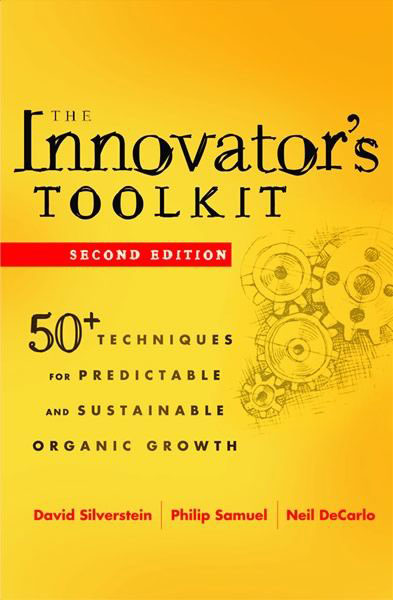A step-by-step guide to systematic, repeatable, reliable innovation.

Humans have been innovating since before…well…just about everything. In fact, our ability to innovate is, in large part, what makes us human.
Yet for all of our success and experience, we still have little actual knowledge of the innovation process. The Innovator’s Toolkit changes that by providing a step-by-step guide to systematic, repeatable, reliable innovation.

The
Innovator’s
Toolkit
50+ TECHNIQUES FOR PREDICTABLE AND
SUSTAINABLE ORGANIC GROWTH
Following years of research by their team of more than 20 researchers, Samuel, Silverstein and DeCarlo draw upon the entire team’s personal experiences and insights as well as best-in-class research from people like Clayton Christensen of the Harvard Business School, Eric von Hippel of MIT, Edward de Bono, Michael Kirton, George Land, and many others.
While these many brilliant minds have codified elements of the process by which humans innovate, the Innovator’s Toolkit offers the first systematic approach that can be referred to as a methodology, not merely a set of tools.
The authors’ D4 Process (Design, Discover, Develop, Demonstrate) enables individuals and teams to follow a step-by-step process, drawing upon proven tools and approaches, while still encouraging the freedom of thought that is ultimately at the heart of all innovation.

27,354
Books Sold

2,391
eBooks Downloaded

2,154
Students Taught
Request a free copy of the Introductory Chapter
ABOUT THE AUTHORS

David Silverstein is a highly regarded strategist, innovator, author and public speaker who enjoys working with clients to tackle their toughest problems. He combines his uniquely extensive set of skills, developed through never-ending education, research and a broad range of hands-on experiences to offer his clients bold and well-informed insight.
A frequent speaker and media source on topics related to innovation, strategy, and economic and global trends, David is best known for his deep insights and ability to see the common threads among seemingly disparate concepts while at the same time making complex subjects easy to understand without losing their significance.
He has been featured in or has written for The Washington Post, The Economist, Inc. Magazine, The Robb Report, CNBC, NPR, Fox News and many other media outlets.
David has also authored several books on innovation and business leadership, most recently publishing additions to the “Connect the Dots Series.”

Dr. Phil Samuel was Managing Partner at Lean Methods Group, who delivers multi-million dollars in value to clients through designing and implementing transformation initiatives. As a frequent public speaker and thought leader in the field of strategy and innovation, he has become a trusted advisor for executives in a variety of industries.
He is passionate about generating organic growth through Product, Process and Business Model Innovation Journeys. He has a reputation for creating competitive advantage through Rapid Innovation Sprints, Innovations Inspired by Nature, and Patent Bulletproofing. He is also well known for re-engineering business processes to generate significant bottom-line results, customer experience, and employee engagement.
Dr. Samuel is also co-author of Design for Lean Six Sigma: A Holistic Approach to Design and Innovation (Wiley).

Neil DeCarlo was a veteran author, editor, and publishing coach whose work has ranged from Lean Six Sigma to corporate finance to strategy—partnering with such firms as BMGI, McKinsey & Company, and many others. DeCarlo is also coauthor of the bestselling Six Sigma For Dummies (Wiley).
REVIEWS
Avis Budget Group, Inc.
INNOVATION TOOLKIT
Select templates to download from a phase of the D4 process
| Title | Exhibit # | Page # | |
|---|---|---|---|
| Structure of a Job Statement | 1.3 | 10 | |
| JTBD Prioritization | 1.4 | 11 | |
| Outcome Expectations | 3.1 | 21 | |
| Opportunity Prioritization | 3.2 | 25 | |
| Problem Statement Prioritization Matrix | 7.2 | 54 | |
| Nine Windows Architecture | 8.1 | 58 | |
| Nine Windows Solution Ideas | 8.2 | 62 | |
| Job Scoping | 9.1 | 65 | |
| Stakeholder Diagnostic | 10.1 | 70 | |
| Power and Influence Map | 10.2 | 71 | |
| Leverage Matrix | 10.3 | 73 | |
| Innovation Project Charter | 12.1 | 84 | |
| Initial Assumptions | 13.2 | 93 | |
| Reverse Income Statement | 13.3 | 94 | |
| Pro Forma Operations Specs | 13.4 | 94 | |
| Updated Income Statement | 13.5 | 95 | |
| Milestones and Assumptions | 13.6 | 97 |
| Title | Exhibit # | Page # | |
|---|---|---|---|
| Functional Analysis and Trimming Worksheet | 15.3 | 113 | |
| Creative Challenge Matrix | 17.2 | 128 | |
| HIT Matrix | 18.1 | 132 | |
| SCAMPER Guidelines and Example | 19.1 | 135 | |
| Brainwriting 6-3-5 | 20.1 | 139 | |
| Imaginary Brainstorming | 21.1 | 142 | |
| Provocation and Movement | 24.1 | 156 | |
| Contradiction Matrix Cross Section | 26.3 | 170 | |
| Idea Sorting—Before | 31.1 | 200 | |
| Idea Sorting—After | 31.2 | 202 | |
| Idea Refinement—Operationalize the Idea | 31.3 | 203 | |
| Idea Refinement—Reinforce the Idea | 31.4 | 204 |
| Title | Exhibit # | Page # | |
|---|---|---|---|
| Functional Requirements | 33.1 | 220 | |
| Morphological Matrix | 36.1 | 238 | |
| Morphological Matrix Design Concepts | 36.2 | 239 | |
| Another Morphological Matrix Example | 36.3 | 240 | |
| TILMAG Matrix | 37.1 | 243 | |
| TILMAG Design Concepts | 37.2 | 244 | |
| Pugh Matrix Example | 40.1 | 259 | |
| Overall Performance Scorecard | 43.1 | 276 | |
| Overall Component Scorecard | 43.3 | 280 | |
| Component Scorecard | 43.4 | 281 | |
| Overall Process Scorecard | 43.5 | 282 | |
| Process Scorecard | 43.6 | 283 | |
| Design FMEA | 44.1 | 287 | |
| Severity of Effect | 44.2 | 288 | |
| Likelihood of Occurrence | 44.3 | 289 | |
| Likelihood that Control Will Detect or Prevent Failure | 44.4 | 290 |
| Title | Exhibit # | Page # | |
|---|---|---|---|
| Function Audit | 48.1 | 320 | |
| Pilot Charter | 49.1 | 324 | |
| SIPOC Map | 50.2 | 332 | |
| Attribute MSA Worksheet | 52.1 | 344 | |
| Attribute MSA Results | 52.2 | 345 | |
| Conjoint Analysis Matrix | 54.1 | 356 | |
| Conjoint Analysis Ratings | 54.2 | 357 | |
| Conjoint Analysis Utility Score | 54.3 | 358 | |
| Common Cause & Effect Diagram Categories | 56.1 | 369 | |
| Cause & Effect Matrix | 57.1 | 372 | |
| Control Plan | 85.1 | 376 |
STAY CONNECTED!
Receive information on upcoming Lean Methods Group training & workshops
Copyright 2022 © Lean Methods Group, LLC. All Rights Reserved.

